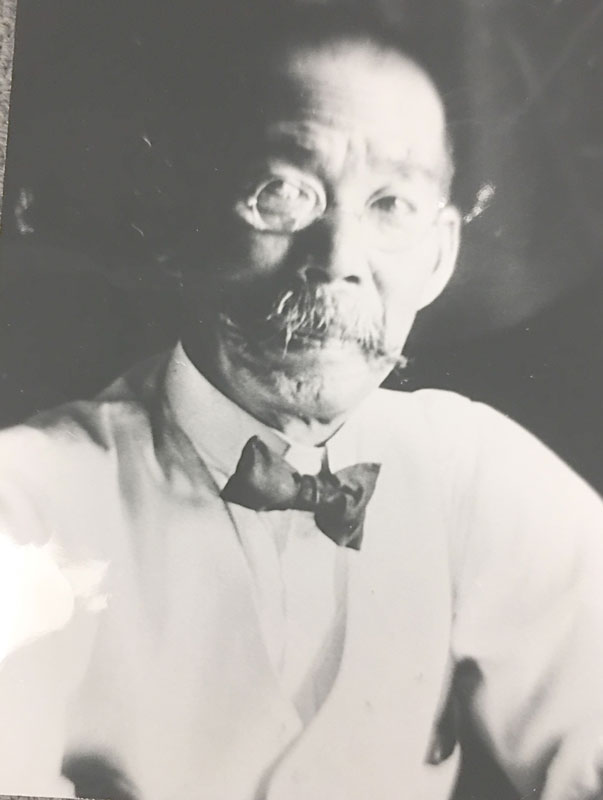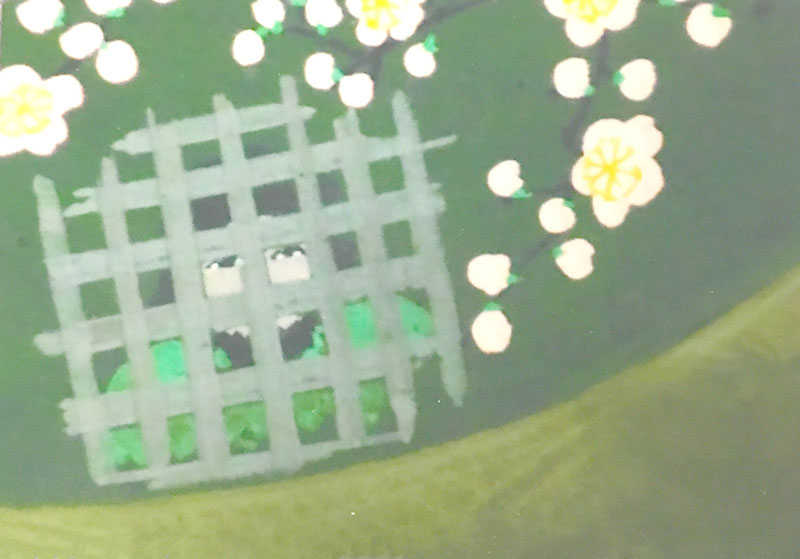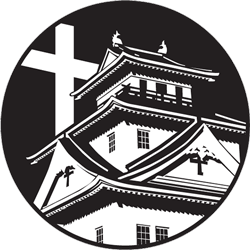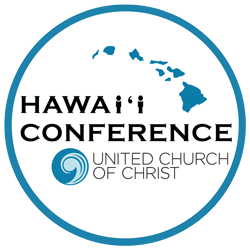Pictured above: Hand-painted ceiling panels in the sanctuary at Makiki Christian Church by artist Yunosuke Ogura.
Wayne Tadaki is the Coordinator at Theodore Ogoshi Archives at Makiki Christian Church. He writes a series of historical articles about Makiki Christian Church for the churchʻs newsletter.
Many of us may not want to admit it, but during (the few) not-so-stirring moments of otherwise awe-inspiring sermons, our eyes have wandered lazily upward and been delighted to see the brightly colored ceiling panels in the sanctuary. How many are there? Who painted them? Did the artist paint them lying on his back like Michelangelo in the Sistine Chapel?
In 1979, Joanne Chow wrote a paper for a sociology class titled, “ The Ogura Family.” The following excerpts are from that paper:
“In my great-grandfather’s case it was not a desire for better living conditions or a road-to-riches notion that led him to settle in Hawaii. These reasons were not his goals and Hawaii was no economic challenge because he came from a wealthy family. His father owned many rice fields and a shoyu factory.
Instead, it was a personal pursuit to quench a burning desire to pursue the field of art. . . . . It was an age-old tale of a father setting ideals for a son who did not resign himself to these ideals.
Yunosuke Ogura, my great-grandfather, ran away from home because his father wanted him to become a doctor. In 1884, he caught a British sailing vessel at Yokohama. He worked deep in the bowels of the vessel shoveling coal, subsisted on hard crackers and coffee, and cleaned his laundry by tying it to a fishing pole and dipping it into the sea. But Yunosuke was an artist at heart; he had loved and studied art when he was young. While on leave during his sea travels, he stopped at many ports worldwide starting with Hong Kong, then sailing on to Germany, France, and England. He spent as much time as he could studying in numerous art galleries. He often told his children of “going everywhere, except Africa.”
After travelling for two years, Yunosuke wanted to return to Japan but learned that his father had since died. After hearing that his brother-in-law had sold the family’s estate and shoyu factory in Chiba, Yunosuke decided to “jump ship” in Honolulu and he and several of his shipmates went ashore and hid in Punchbowl crater for several days. They eventually came down when they saw the ship pull out of the harbor.
With 75 cents in his pocket, Yunosuke found a job at William’s Framework on Union Street, where he was hired to draw and tint photographs. He did this for a year, then returned to Japan in 1887 to find a wife. He and his wife, Shu, eventually relocated to Hawaii, where they raised eight children. Yunosuke worked for about 10 years for King Brothers on Hotel Street to support his family.
To his children, Yunosuke stressed that since they were living in America, they should speak, dress and act so in order to conform. One aspect of being American, he felt, was adopting an American religion. All of his children were required to attend church regularly. It also helped that Reverend Takie Okumura and Yunosuke were good friends. Rev. Okumura was known to be a prominent figure in motivating the Issei and Nissei to Americanize and display patriotism for the United States.
Reverend Okumura asked his artist friend, Yunosuke, to paint the ceilings of Makiki Church’s new sanctuary and foyer. It is not known who decided on the floral theme of the paintings, but they were done to add a complimentary, serene feeling to the glory of nature. Each of the 161 panels of flowers and plants had to be individually painted before installation.”
(The “rest of the story,” is compiled from excerpts from a 1932 MCC booklet, a 1987 MCC Bulletin, a 1956 Honolulu Advertiser article written by Patsy Saiki, a Spring 1979 article in the Waihona, from Wikipedia and from this author’s personal observations).

Artist Yunosuke Ogura
“Yunosuke was considered to be the first ethnically Japanese painter of any stature to paint Hawaiian subjects and was known for being an artist from the Volcano School of painters. The Volcano School refers to a group of non-native Hawaiian artists who painted dramatic nocturnal scenes of Hawaii’s erupting volcanoes. Kilauea and Mauna Loa were intermittently active during the 1880s and 1890s, when interest in Volcano School paintings peaked. Getting to Kilauea required an arduous two to three day roundtrip journey on horseback. One of Yunosuke’s paintings, titled, ‘Kilauea,’ is part of the Volcano School collection of paintings in the Honolulu Museum of Art.”
There are 116 painted panels in our church’s sanctuary, and another 45 panels plus two murals in the foyer. If you have the time and interest, when the sanctuary and foyer are lit but not crowded, try studying the ceilings with binoculars or camera with telephoto lens. In the sanctuary you will see brilliant renditions of flora of all kinds. Maple, chrysanthemum, morning glory, pomegranate, hibiscus, irises, sakura and ume, botan, sunflower, jasmine, melon, pear, daises, lilies and more. Look more carefully and you will also see assorted fauna among the flowers; bees, wasps, frogs, dragonflies, and butterflies. The mural on the Elm Street side of the foyer depicts a bamboo grove scene and the mural on the Rycroft side is a landscape scene of a beautiful pine tree with Fuji-san in the background. All of the paintings are said to have been donated by Yunosuke to Makiki Christian Church.
The most intriguing works by the artist are on the ceiling panels in the foyer. A number of panels have peculiar objects painted within the floral designs, some represent or recreate in picture form old proverbs or enigmatic poems. A panel of morning glories with a wooden bucket and well is based on a poem by the famous Haiku poetess of the Edo period, Kaga-no-Chiyo:

“Morning glories blooming on my well bucket
I borrow water from my neighbor’s well.”
One panel with a shoe in a melon patch admonishes: “When in a melon patch, do not stop to tie your shoelaces” (lest you be mistaken for a melon thief).

And a third panel with a straw hat and pears warns, “When in a pear orchard, do not raise your hand to your hat,” (lest you be mistaken for a pear thief). There are 6 other panels with objects “hidden” within the paintings. One has a globe highlighting Japan, another has a partial moon among pink sakura blossoms, one has a Japanese fan, one with a horse’s head, another has a scroll with written kanji. And the most intriguing panel of all. In the corner of the panel with the pink ume (plum) flowers (and the only panel among all the panels with a human figure in it) there appears to be a heavily bearded man with long black hair, wide eyes staring out from behind thick wooden bars. Who is that? Is it the painter trying to tell us something? What is the message here? Explanations of these last six panels have not yet been found by this author. Can anyone help to decipher the meanings of these paintings?
Ogura-san must have really loved nature and admired, with a true artist’s heart, God’s creative genius for beauty. He also seemed to have had a wry sense of humor and fondness for the veiled mysteries of our wonderful universe.
God has worked mightily and memorably through the years in our church through the lives of men and women such as Rev. Takie and Mrs. Katsu Okumura, Chuck and Sue Wang, Frank and Sumako Murakami, Itsuki Kodama, and Yunosuke Ogura. Thank you, God, for enriching the lives of so many of your followers of your church and for showing the world-at-large the magnificence of your works, and the depth of your love.



